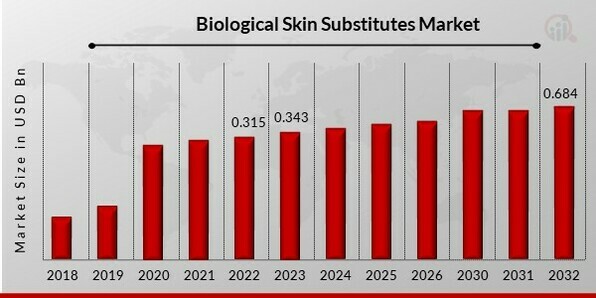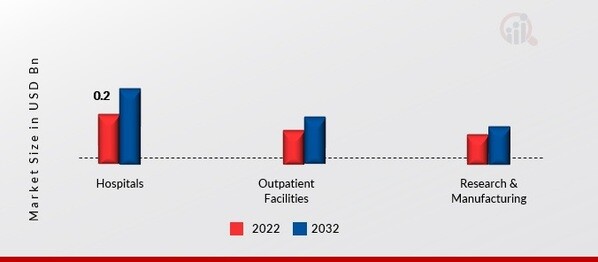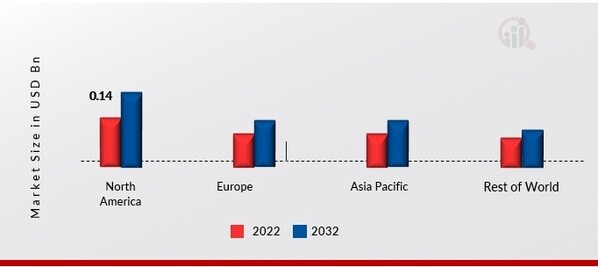Global Biological Skin Substitutes Market Overview
Biological Skin Substitutes Market Size was valued at USD 0.315 Billion in 2022. The Biological Skin Substitutes market industry is projected to grow from USD 0.343 Billion in 2023 to USD 0.684 Billion by 2032, exhibiting a compound yearly growth rate (CAGR) of 9.00% during the forecast period (2024 - 2032). Increased prevalence of chronic wounds, burns, and skin-related disorders and adoption of advanced wound care technologies are the key market drivers improving the growth of market.

Source: The Primary Research, Secondary Research, MRFR Database and Analyst Review
Biological Skin Substitutes Market Trends
- Growing prevalence of chronic wounds, burns, and skin-related disorders is driving the market growth
Market CAGR for biological skin substitutes is being driven by the increasing prevalence of the chronic wounds, burns, and skin-related disorders, reflecting the increasing demand for advanced wound care solutions. Rising incidence of the chronic conditions like diabetes, vascular diseases, and pressure ulcers has contributed to a growing patient population with non-healing wounds, necessitating effective and innovative approaches to wound management. Biological skin substitutes offer a promising solution by addressing the challenges associated with chronic wounds, promoting rapid healing, and minimizing the risk of complications.
Chronic wounds, inclusive of diabetic foot ulcers, venous ulcers, and pressure ulcers, present a substantial healthcare burden globally. The aging population, coupled with lifestyle factors, has led to a higher prevalence of the chronic diseases, contributing to an increased occurrence of chronic wounds. Traditional wound care methods often face limitations in promoting optimal healing in these cases, creating a demand for advanced wound care technologies. Biological skin substitutes, comprising living cells and/or biomaterials, are designed to mimic the structure and function of natural skin, providing a conducive environment for tissue regeneration. Burn injuries, both thermal and chemical, represent another significant driver for the adoption of biological skin substitutes. Severe burns can result in extensive tissue damage, impairing the body's ability to heal on its own. Biological skin substitutes offer a therapeutic alternative by providing a scaffold for cell growth and facilitating the regeneration of functional skin tissue. This is particularly crucial in cases where traditional methods, such as autografts, are not feasible due to the limited availability of healthy donor sites.
The prevalence of skin-related disorders, such as epidermolysis bullosa and genetic skin diseases, also contributes to the growth of the biological skin substitute market. Patients with these conditions often experience compromised skin integrity, making them susceptible to chronic wounds and infections. Biological skin substitutes can serve as an effective intervention by promoting wound healing and improving the complete quality of life for the individuals affected by these disorders. The market growth is further driven by advancements in tissue engineering and regenerative medicine. Ongoing research and the development efforts focus on enhancing the efficacy of biological skin substitutes, improving their integration with the host tissue, and expanding their applicability across different wound types. As these technologies evolve, the market is expected to witness the introduction of more sophisticated and tailored solutions catering to specific patient needs and clinical scenarios. Thus driving the Biological Skin Substitutes market revenue.
Biological Skin Substitutes Market Segment Insights
Biological Skin Substitutes Type Insights
The Biological Skin Substitutes Market segmentation, based on type, includes Human Donor Tissue-Derived Products and Acellular Animal-Derived Products. The human donor tissue-derived products segment dominated the market, accounting for the biggest market revenue due to their biological similarity to natural skin, facilitating enhanced integration and promoting effective wound healing. These products, sourced from human cadavers or tissue donations, provide a structural framework that supports cell proliferation and tissue regeneration. The use of human-derived tissue offers a versatile and comprehensive solution for a variety of wound types, including chronic wounds and burns, as it closely resembles the native extracellular matrix.
Biological Skin Substitutes Application Insights
The Biological Skin Substitutes Market segmentation, based on application, includes Acute Wounds and Chronic Wounds. The acute wounds category dominates the market due to its versatility and efficacy in addressing immediate wound care needs. Acute wounds, including surgical incisions, traumatic injuries, and abrasions, require prompt and efficient interventions to facilitate rapid healing and minimize complications. Biological skin substitutes excel in this context by providing a structured framework for cell proliferation and tissue regeneration, accelerating the natural healing process. Their ability to promote faster closure of acute wounds, reduce scarring, and enhance overall wound management makes them a preferred choice. The chronic wound segment is anticipated to experience the fastest growth rate over the forecast period. This is due to the rising prevalence of chronic wounds like diabetic venous leg ulcers, foot ulcers, pressure ulcers, etc.
Biological Skin Substitutes End-Use Insights
The Biological Skin Substitutes Market segmentation, based on end use, includes Hospitals, Outpatient Facilities, and Research and manufacturing. The hospitals category dominates the market due to their central role in acute and chronic wound care management. These healthcare institutions, equipped with specialized wound care facilities and skilled medical professionals, are primary sites for treating patients with severe burns, chronic wounds, and complex skin disorders. The preference for biological skin substitutes in hospital settings stems from their efficacy in promoting tissue regeneration, reducing infection risks, and enhancing overall wound healing outcomes. The outpatient facilities segment is foreseen to witness the fastest growth over the forecast period. Outpatient facilities such as wound care centers are gaining attraction among patients.
Figure 1: Biological Skin Substitutes Market, by End Use, 2023 & 2032 (USD Billion)

Source: The Primary Research, Secondary Research, MRFR Database and Analyst Review
Biological Skin Substitutes Regional Insights
By region, the study gives market insights of North America, Europe, Asia-Pacific, and the Rest of the World. The North American Biological Skin Substitutes market area dominates this market due to surged prevalence of chronic diseases, advanced healthcare infrastructure, and robust research and development activities. The region's well-established regulatory framework, coupled with a growing demand for innovative wound care solutions, positions North America as a leader.
Further, the prime countries studied in the market report are the US, Canada, Germany, France, the UK, Italy, Spain, Japan, China, India, Australia, South Korea, and Brazil.
Figure 2: BIOLOGICAL SKIN SUBSTITUTES MARKET SHARE BY REGION 2023 (USD Billion)

Source: The Primary Research, Secondary Research, MRFR Database and Analyst Review
Europe's Biological Skin Substitutes market accounts for the second-largest market revenue share due to the rising incidence of chronic wounds, a well-developed healthcare infrastructure, and a strong emphasis on advanced wound care technologies. Further, the German Biological Skin Substitutes market held the largest market share, and the UK Biological Skin Substitutes market was the fastest-growing market in the European region.
The Asia-Pacific Biological Skin Substitutes Market is expected to grow at the fastest CAGR from the year 2023 to 2032. This is due to the increasing incidence of chronic wounds, a rising aging population, and the growing awareness of advanced wound care solutions. Moreover, China’s Biological Skin Substitutes market held the largest market share, and the Indian Biological Skin Substitutes market was the fastest-growing market in Asia-Pacific region.
Biological Skin Substitutes Key Market Players & Competitive Insights
Leading market players are investing heavily in the research and development in order to expand their product lines, which will help the Biological Skin Substitutes market grow even more. Market players are also undertaking different strategic activities for expanding their global footprint, with important market developments inclusive of mergers and acquisitions, new product launches, contractual agreements, higher investments, and collaboration with the other organizations. To expand and survive in the more competitive and rising market climate, the Biological Skin Substitutes industry must offer cost-effective items.
Manufacturing locally to minimize the operational costs is one of the key business tactics used by the manufacturers in the global Biological Skin Substitutes industry to benefit the clients and grow the market sector. In recent years, the Biological Skin Substitutes industry has provided some of the most significant advantages to medicine. Major players in the Biological Skin Substitutes market, including Organogenesis, Inc. 3M, Integra LifeSciences, Smith and Nephew, Tissue Regenix, Mimedx, BSN medical, Stryker, Vericel Corporation., Mallinckrodt, and others, are trying to raise teh market demand by investing in research and development operations.
MiMedx is a regenerative medicine company based in Marietta, Georgia, known for its focus on developing and commercializing innovative bioactive technologies, including tissue grafts and therapeutic solutions. Established in 2006, the company has become a prominent player in the field of advanced wound care, offering products designed to support the body's natural healing processes. MiMedx specializes in the processing and manufacturing of human amniotic membrane-derived products, which are utilized in various applications, including wound care, surgical procedures, and orthopedic applications. MiMedx and Histogenex announced a collaboration in October 2023 to develop and commercialize Histogenex's investigational skin substitute product, NeoCart, for the treatment of chronic wounds. This partnership combines MiMedx's expertise in placental tissue processing with Histogenex's innovative cell-based technology.
Organogenesis is a pioneering regenerative medicine company at the forefront of developing and delivering advanced solutions for wound care, surgical, and sports medicine applications. Established in 1985, the company has been a key player in the field of tissue engineering and regenerative medicine, providing innovative products that harness the body's natural healing capabilities. Organogenesis is particularly known for its expertise in the development of bioactive and bioresorbable extracellular matrix (ECM) technologies, which serve as the foundation for their products. Organogenesis and Purdue University partnered in July 2023 to advance research and development of bioengineered skin substitutes for burn treatment. This collaboration aims to utilize Purdue's expertise in stem cell technology and Organogenesis' experience in skin substitute manufacturing to create personalized and effective burn treatments.
Key Companies in the Biological Skin Substitutes market include
- Organogenesis, Inc.
- 3M
- Integra LifeSciences
- Smith and Nephew
- Tissue Regenix
- Mimedx
- BSN Medical
- Stryker
- Vericel Corporation.
- Mallinckrodt
Biological Skin Substitutes Industry Developments
June 2023: Stemedica and Cytograft Tissue Engineering: Formed a strategic partnership to compile their respective strengths in stem cell-based therapies and bioprinted skin substitutes. This collaboration focuses on developing next-generation skin substitutes for wound healing and burn repair.
November 2023: Biotronik, a medical device company, acquired TissueGen, a leading developer of biosynthetic skin substitutes for reconstructive surgery applications. This acquisition strengthens Biotronik's product portfolio in the reconstructive surgery market.
September 2023: Medtronic, a global medical technology company, acquired Vericel Corporation, a prominent player in the biological skin substitutes market. This acquisition expands Medtronic's offering of wound care solutions and provides access to Vericel's portfolio of acellular dermal matrices.
Biological Skin Substitutes Market Segmentation
Biological Skin Substitutes Type Outlook
- Human Donor Tissue-Derived Products
- Acellular Animal-Derived Products
Biological Skin Substitutes Application Outlook
- Acute Wounds
- Chronic Wounds
Biological Skin Substitutes End-Use Outlook
- Hospitals
- Outpatient Facilities
- Research & Manufacturing
Biological Skin Substitutes Regional Outlook
-
North America
-
Europe
- Germany
- France
- UK
- Italy
- Spain
- Rest of Europe
-
Asia-Pacific
- China
- Japan
- India
- Australia
- South Korea
- Australia
- Rest of Asia-Pacific
-
Rest of the World
- Middle East
- Africa
- Latin America
| Report Attribute/Metric |
Details |
| Market Size 2022 |
USD 0.315 Billion |
| Market Size 2023 |
USD 0.343 Billion |
| Market Size 2032 |
USD 0.684 Billion |
| Compound Annual Growth Rate (CAGR) |
9.00% (2024-2032) |
| Base Year |
2023 |
| Market Forecast Period |
2024-2032 |
| Historical Data |
2018- 2022 |
| Market Forecast Units |
Value (USD Billion) |
| Report Coverage |
Revenue Forecast, Market Competitive Landscape, Growth Factors, and Trends |
| Segments Covered |
Type, Application, End Use, and Region |
| Geographies Covered |
North America, Europe, Asia Pacific, and the Rest of the World |
| Countries Covered |
The US, Canada, Germany, France, UK, Italy, Spain, Japan, China, India, Australia, South Korea, and Brazil |
| Key Companies Profiled |
Organogenesis, Inc. 3M, Integra LifeSciences, Smith and Nephew, Tissue Regenix, Mimedx, BSN medical, Stryker, Vericel Corporation., Mallinckrodt |
| Key Market Opportunities |
· Rising adoption of advanced wound care technologies. |
| Key Market Dynamics |
· Increased prevalence of chronic wounds, burns, and skin-related disorders. |
Frequently Asked Questions (FAQ) :
The Biological Skin Substitutes Market size was valued at USD 0.315 Billion in 2022.
The global market is foreseen to rise at a CAGR of 9.00% during the forecast period, 2024-2032.
North America held the biggest share of the global market
The prime players in the market are Organogenesis, Inc. 3M, Integra LifeSciences, Smith and Nephew, Tissue Regenix, Mimedx, BSN Medical, Stryker, Vericel Corporation., and Mallinckrodt.
The human donor tissue-derived products category dominated the market in 2022.
The acute wounds had the largest share in the global market.





























